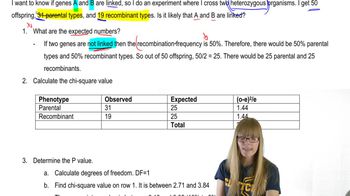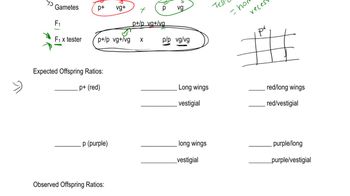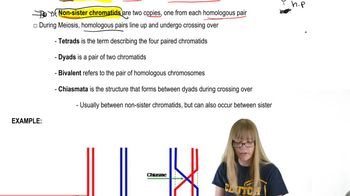Table of contents
- 1. Introduction to Genetics51m
- 2. Mendel's Laws of Inheritance3h 37m
- 3. Extensions to Mendelian Inheritance2h 41m
- 4. Genetic Mapping and Linkage2h 28m
- 5. Genetics of Bacteria and Viruses1h 21m
- 6. Chromosomal Variation1h 48m
- 7. DNA and Chromosome Structure56m
- 8. DNA Replication1h 10m
- 9. Mitosis and Meiosis1h 34m
- 10. Transcription1h 0m
- 11. Translation58m
- 12. Gene Regulation in Prokaryotes1h 19m
- 13. Gene Regulation in Eukaryotes44m
- 14. Genetic Control of Development44m
- 15. Genomes and Genomics1h 50m
- 16. Transposable Elements47m
- 17. Mutation, Repair, and Recombination1h 6m
- 18. Molecular Genetic Tools19m
- 19. Cancer Genetics29m
- 20. Quantitative Genetics1h 26m
- 21. Population Genetics50m
- 22. Evolutionary Genetics29m
4. Genetic Mapping and Linkage
Crossing Over and Recombinants
Problem 8
Textbook Question
What two essential criteria must be met in order to execute a successful mapping cross?
 Verified step by step guidance
Verified step by step guidance1
Understand that a mapping cross is used to determine the relative positions of genes on a chromosome.
The first essential criterion is that the organisms used in the cross must be heterozygous for the genes being mapped. This ensures that recombination can be observed.
The second essential criterion is that there must be a way to identify the different genotypes of the offspring, often through phenotypic markers or molecular techniques.
Ensure that the sample size is large enough to detect recombination events accurately, as small sample sizes can lead to statistical errors.
Finally, calculate the recombination frequency between the genes, which is used to estimate the distance between them on the chromosome.
Recommended similar problem, with video answer:
 Verified Solution
Verified SolutionThis video solution was recommended by our tutors as helpful for the problem above
Video duration:
2mPlay a video:
Was this helpful?
Key Concepts
Here are the essential concepts you must grasp in order to answer the question correctly.
Genetic Linkage
Genetic linkage refers to the tendency of genes located close to each other on a chromosome to be inherited together during meiosis. Understanding linkage is crucial for mapping crosses, as it affects the recombination frequency and the resulting genetic map. The closer two genes are, the less likely they are to be separated by recombination, which influences the accuracy of the mapping results.
Recommended video:
Guided course

Chi Square and Linkage
Recombination Frequency
Recombination frequency is the measure of how often recombination occurs between two genes during meiosis. It is expressed as a percentage and is used to estimate the distance between genes on a chromosome. A successful mapping cross requires a measurable recombination frequency to determine the relative positions of genes, which is essential for constructing a genetic map.
Recommended video:
Guided course

Recombination after Single Strand Breaks
Parental and Recombinant Types
In a mapping cross, parental types are the offspring that inherit the same combination of alleles as the parents, while recombinant types have new combinations due to crossing over. Identifying these types is essential for calculating recombination frequency and determining linkage relationships. A successful mapping cross must yield a sufficient number of both types to ensure accurate mapping of genetic traits.
Recommended video:
Guided course

Recombination after Single Strand Breaks

 7:52m
7:52mWatch next
Master Gamete Genotypes with a bite sized video explanation from Kylia Goodner
Start learning




